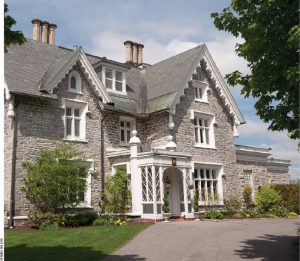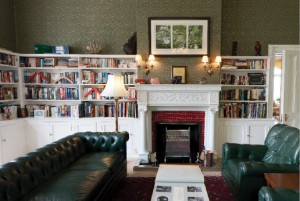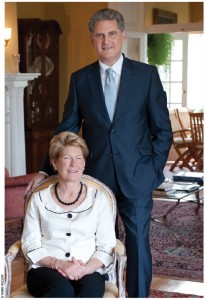
Settled comfortably into gracious gardens, Earnscliffe, the elegant grey limestone residence of British High Commissioner Andrew Pocock and his wife, Julie, looks much the same as when it housed Canada’s first prime minister, Sir John A. Macdonald. The stone is mellow with age and the bright, white gingerbread trim reflects the Victorian Gothic style of the mid-19th Century.
Originally built in 1855 for John McKinnon, a local businessman and son-in-law of Thomas McKay, it was sold to local railwayman Thomas Reynolds in 1870, and eventually purchased by Sir John A. in 1883 for $10,040. He gave it the name Earnscliffe, meaning “eagle’s cliff” for its stunning location overlooking the Ottawa River and Quebec. He made some alterations to the house and following his death in 1891, his widow, Baroness Macdonald of Earnscliffe, sold it to Dr. Charles Harriss. In 1930, Prime Minister R.B. Bennett passed up the opportunity to purchase the house as a Canadian prime ministerial residence, opening the door for Britain’s first high commissioner to Canada, Sir William Clark, to buy it on behalf of the British government.
Today, Earnscliffe’s circular driveway leads to the heavily detailed Victorian- style portico, where guests are greeted on the porch by the bust of Sir John A. and in the hall by a bronze statue of King Edward Vll.
Echoes of the former owner are everywhere. The high commissioner’s study still contains the original fireplace and bookshelves that line the walls. The patterned wallpaper is reminiscent of designs by Victorian architect Augustus Pugin. A large desk overlooks the garden.

“It is used today the same way as then,” says the high commissioner.
The main reception room was originally two rooms put together in 1874. Painted an historical yellow, the decor includes pink sofas, checkered chairs and a grand piano. Behind the piano is the River Room, a small, cozy spot with a lovely view, and nearby, the conservatory, a flower-filled retreat added in 1930 by enclosing the original verandah.
Perhaps the most interesting enhancement to the house is the large dining room added at the back end by Macdonald. Now with a dining room table that seats 30, it was remodelled several times, culminating in the installation in the 1950s of a picture window looking out at the Gatineau hills.
“One of the glories is looking at ‘la belle Province,’” Mr. Pocock says. “When we arrived in January, the river was just a sheet of ice and snow, white as far as the eye could see, and we’ve seen it transform itself back into summer.”

Period atmosphere permeates the house, from the main-stair banisters with their matching pairs of spindles typical of 19th-Century Ontario homes and the period wallpaper in what was Macdonald’s large and airy bedroom, one of the three on the second floor, and the place where the country’s first prime minister died. It was here that the High Commissioner’s brother made an interesting discovery. Because he was staying in that bedroom, he checked out the art on the walls and found a small landscape painting by their ancestor, Nicholas Pocock, a well-known British naval artist who lived from the mid-18th to the mid-19th Century.
Perhaps the most charming element in the house is the small seat on the landing at the top of the back stairs. Here Sir. John’s A’s much-loved disabled daughter Mary could sit and watch her father’s distinguished and glittery guests going into dinner.
The high commission boasts the services of star chef John Leung, who often uses his skills to serve English and Scottish specialties, including venison and home-cured salmon.
“At a reception to celebrate the royal wedding, we served the same menu as the one at Buckingham Palace,” says Mrs. Pocock. But while they fêted their wedding, they won’t be entertaining the royal couple when they come to Canada since the Canadian government is playing host.
Earnscliffe also has a small cottage industry, bottling maple syrup from trees on the property, small packages of chocolate truffles and even crab-apple jelly, all logo-ed with a picture of the house.
The landscaped grounds include a limestone carriage house built by Sir. John A., which now houses a couple of staff members. The grounds also offer a view to the south of the rusty sides of the Macdonald-Cartier Bridge, an eyesore no one much talks about.
Mrs. Pocock is more interested in her plans for a formal diamond-shaped rose garden to be created on the grounds to acknowledge Queen Elizabeth’s 2012 Diamond Jubilee. To be built on a sunny spot near the front door, the diamond will be filled appropriately with red and white roses among others, all planted to bloom just in time for next summer’s celebrations.




